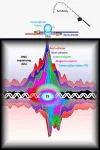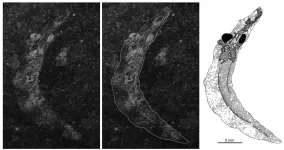The study, published today (10 March 2021) in Nature, found evidence to support the theory of the placenta as a 'dumping ground' for genetic defects, whereas the fetus corrects or avoids these errors. The findings provide a clear rationale for studying the association between genetic aberrations and birth outcomes, in order to better understand problems such as premature birth and stillbirth.
In the earliest days of pregnancy, the fertilized egg implants into the wall of the uterus and begins dividing from one cell into many. Cells differentiate into various types of cell and some of them will form the placenta. Around week ten of pregnancy, the placenta begins to access the mother's circulation, obtaining oxygen and nutrients for the fetus, removing waste products and regulating crucial hormones*.
It has long been known that the placenta is different from other human organs. In one to two per cent of pregnancies, some placental cells have a different number of chromosomes to cells in the fetus - a genetic flaw that could be fatal to the fetus, but with which the placenta often functions reasonably normally.
Despite this genetic robustness, problems with the placenta are a major cause of harm to the mother and unborn child, such as growth restriction or even stillbirths.
This new study is the first high-resolution survey of the genomic architecture of the human placenta. Scientists at the Wellcome Sanger Institute and the University of Cambridge conducted whole genome sequencing of 86 biopsies and 106 microdissections from 42 placentas**, with samples taken from different areas of each organ.
The team discovered that each one of these biopsies was a genetically distinct 'clonal expansion' - a cell population descended from a single common ancestor - indicating a clear parallel between the formation of the human placenta and the development of a cancer.
Analysis also identified specific patterns of mutation that are commonly found in childhood cancers, such as neuroblastoma and rhabdomyosarcoma, with an even higher number of these mutations in the placenta than in the cancers themselves.
Professor Steve Charnock-Jones, a senior author of the study from the University of Cambridge, said: "Our study confirms for the first time that the placenta is organised differently to every other human organ, and in fact resembles a patchwork of tumours. The rates and patterns of genetic mutations were also incredibly high compared to other healthy human tissues."
The team used phylogenetic analysis to retrace the evolution of cell lineages from the first cell divisions of the fertilised egg and found evidence to support the theory that the placenta tolerates major genetic flaws.
In one biopsy, the researchers observed three copies of chromosome 10 in each cell, two from the mother and one from the father, instead of the usual one copy from each parent. But other biopsies from the same placenta and from the fetus carried two copies of chromosome 10, both from the mother. A chromosomal copy number error such as this in any other tissue would be a major genetic flaw***.
Professor Gordon Smith, a senior author of the study from the University of Cambridge, said: "It was fascinating to observe how such a serious genetic flaw as a chromosomal copy number error was ironed out by the baby but not by the placenta. This error would have been present in the fertilized egg. Yet derivative cell populations, and most importantly those that went on to form the child, had the correct number of copies of chromosome 10, whereas parts of the placenta failed to make this correction. The placenta also provided a clue that the baby had inherited both copies of the chromosome from one parent, which can itself be associated with problems."
Now that the link between genetic aberrations in the placenta and birth outcomes has been established, further studies using larger sample sizes could help to uncover the causes of complications and diseases that arise during pregnancy.
Dr Sam Behjati, a senior author of the study from the Wellcome Sanger Institute, said: "The placenta is akin to the 'wild west' of the human genome, completely different in its structure from any other healthy human tissue. It helps to protect us from flaws in our genetic code, but equally there remains a high burden of disease associated with the placenta. Our findings provide a rationale for studying the association between genetic aberrations in the placenta and birth outcomes at the high resolution we deployed and at massive scale."
INFORMATION:
Contact details:
Dr Matthew Midgley
Press Office
Wellcome Sanger Institute
Cambridge, CB10 1SA
Phone: 01223 494856
Email: press.office@sanger.ac.uk
Notes to Editors:
*The Society for Endocrinology has more information on the role of the placenta during pregnancy: https://www.yourhormones.info/glands/placenta/
** All samples were sourced from the Pregnancy Outcome Prediction (POP) study: https://www.obgyn.cam.ac.uk/research/pops-2/
*** Yourgenome.org has more information on chromosomes and how genetic errors can affect health: https://www.yourgenome.org/facts/what-is-a-chromosome-disorder
Publication:
Tim H. H. Coorens, Thomas R. W. Oliver and Rashesh Sanghvi et al. (2021). Somatic mutations reveal widespread mosaicism and mutagenesis in human placentas. Nature. DOI: https://doi.org/10.1038/s41586-021-03345-1
Funding:
This research was funded by Wellcome and the National Institute for Health Research (NIHR) Cambridge Biomedical Research Centre.
Selected websites:
NIHR
The National Institute for Health Research (NIHR) is the nation's largest funder of health and care research. The NIHR:
* Funds, supports and delivers high quality research that benefits the NHS, public health and social care
* Engages and involves patients, carers and the public in order to improve the reach, quality and impact of research
* Attracts, trains and supports the best researchers to tackle the complex health and care challenges of the future
* Invests in world-class infrastructure and a skilled delivery workforce to translate discoveries into improved treatments and services
* Partners with other public funders, charities and industry to maximise the value of research to patients and the economy
The NIHR was established in 2006 to improve the health and wealth of the nation through research, and is funded by the Department of Health and Social Care. In addition to its national role, the NIHR commissions applied health research to benefit the poorest people in low- and middle-income countries, using Official Development Assistance funding.
This work uses data provided by patients and collected by the NHS as part of their care and support and would not have been possible without access to this data. The NIHR recognises and values the role of patient data, securely accessed and stored, both in underpinning and leading to improvements in research and care. http://www.nihr.ac.uk/patientdata [nihr.ac.uk]
About NIHR Cambridge Biomedical Research Centre
Based within the most outstanding NHS and University partnerships in the country, the Biomedical Research Centres are leaders in scientific translation. Located on the Cambridge Biomedical Campus, they receive substantial levels of funding from the National Institute for Health Research (NIHR) to translate fundamental biomedical research into clinical research that benefits patients and they are early adopters of new treatments. https://cambridgebrc.nihr.ac.uk/
The Wellcome Sanger Institute
The Wellcome Sanger Institute is a world leading genomics research centre. We undertake large-scale research that forms the foundations of knowledge in biology and medicine. We are open and collaborative; our data, results, tools and technologies are shared across the globe to advance science. Our ambition is vast - we take on projects that are not possible anywhere else. We use the power of genome sequencing to understand and harness the information in DNA. Funded by Wellcome, we have the freedom and support to push the boundaries of genomics. Our findings are used to improve health and to understand life on Earth. Find out more at http://www.sanger.ac.uk or follow us on Twitter, Facebook, LinkedIn and on our Blog.
About Wellcome
Wellcome exists to improve health by helping great ideas to thrive. We support researchers, we take on big health challenges, we campaign for better science, and we help everyone get involved with science and health research. We are a politically and financially independent foundation. https://wellcome.org/




